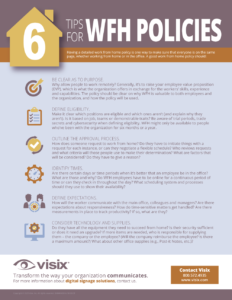Many companies are going to implement some sort of hybrid workplace structure soon (if they haven’t already), and more will follow later. This will change processes and workflows somewhat, most notably in that set work hours will decline for employees that don’t interact with clients or work in spaces where a physical presence is necessary, like a factory or retail shop.
As the number of virtual employees increases, it will be essential to keep them feeling connected to other employees and the organization as a whole.
Keep in Touch
Obviously, there’ll be more interactions of a digital nature. Communications will use more digital channels. And people will have more virtual calls and chats more often, rather than scheduling a long meeting to cover many topics. They’ll also check in more frequently with their managers and teams.
One effect of the increase in the number of interactions is that they’ll most likely become more informal to some extent. This is actually a good thing – virtual employees still want to feel a sense of connectedness and camaraderie. Communicating with people in many short bursts throughout the day actually mimics what it’s like to interact with colleagues in a face-to-face environment.
And you need to be clear about who can work from home when. Having a detailed remote work policy is one way to make sure that everyone is on the same page, regardless of where they’re working. ProjectManager.com has a handy list of various examples and templates for work from home policies. Employers.org has a fill-in-the-blank template that can be adapted to many specific situations and environments.

6 Tips for Work-From-Home Policies
Keep it Personal
While companies may want to try and dictate which technologies everyone will use, that will end up changing to a multi-platform approach before too long. Can you imagine if, in your personal life, you were a TikTok user, but someone required you to use Facebook instead? You might give it a try, but you would never be truly comfortable with that platform.
Instead, we’re going to see more omni-channel communications – the same message replicated on multiple platforms, at least for messaging that needs to be more widespread or is more formal in nature. So, an email for those who still prefer email, an intranet post, a group chat in Teams, all with the same content. Improving workflows and using centralized content management tools will make this a seamless and fairly easy process.
Each organization is going to be different, and each department or team might also be different. The one-size-fits-all approach to management and communications is going away. Yes, there can be a unified corporate culture, but the place is still made up of individuals. And to attract, engage and satisfy employees, you’ll need to cater to the tools and techniques they prefer.
Keep it Friendly
Since the new company will be a virtual one with lots of satellites versus physical offices, it’s more important than ever to have a culture of communication that connects all of these locations and people to let them feel like part of one united whole.
Despite all the effort that goes into making sure virtual employees feel connected and included in work processes, it’s also important to create opportunities for socializing both inside and outside of work. The number one thing people miss when working the majority of time from home is that social interaction, as in catching up about people’s kids, vacations, sports teams they love or love to hate, and so on. This sort of camaraderie building would happen naturally and spontaneously if everyone were in the same environment, but with a sizeable chunk of the workforce operating remotely, it becomes necessary to plan and schedule opportunities for social interaction.
When planning agendas for virtual meetings, be sure to build in some time for general conversation. Do it either at the beginning or the end so people can feel free to catch up without worrying about interrupting the flow. Joining meetings a few minutes early can also give you a little extra time to chat. And encourage people to use their cameras so everyone feels more personal and connected.
At least once a month, there should be some kind of non-work-focused “get together” that combines virtual employees and people on-site. This could be a short trivia match, bingo or any other fun activity. Each event should be fairly short (30 minutes or less) and should be very informal. Naturally, these would have to be voluntary – the point here is to provide this opportunity to those who want it.
With a few simple adjustments, you can ensure that your virtual employees feel just as connected as those coming through the front door every day. It’s really just a matter of being clear, communicative and supportive. And those are things that (we hope) you’re already doing.
